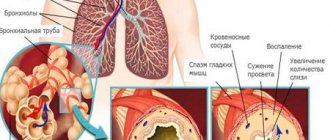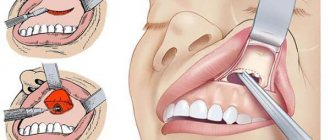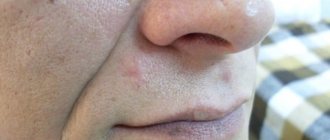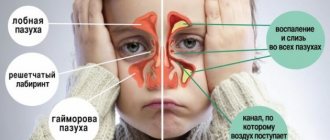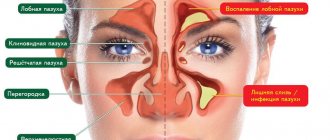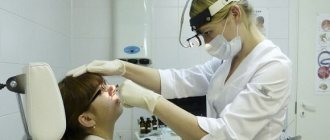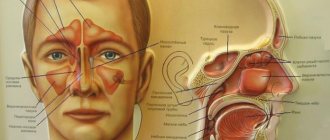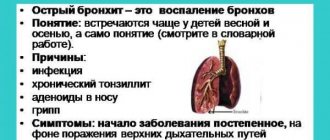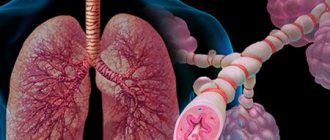What is the reason?
Typically, this symptom accompanies a fairly common disease - sinusitis. In this case, pain is observed in the area of the cheeks, cheekbones, teeth, and eye sockets, which noticeably intensify when the person bends down. Pathogenic microorganisms from the outside enter the human body through the nasal passages, so it is in them that inflammation occurs first. Local immunity enters the fight against the pathogen and most often loses. The term sinusitis combines several types of inflammation, and each of these diseases causes a headache when bending down; This:
- sinusitis - inflammation of the maxillary sinus;
- frontal sinusitis - the frontal sinus is involved in inflammation;
- sphenoiditis - the sphenoid sinus is affected.
The pain itself occurs when bending over due to inflammation and congestion of the nasal sinuses. The reasons why the infection spreads in the sinuses are hypothermia, poor immunity, infections, and colds. Allergies can also cause such inflammation.
The main symptom of sinusitis is the patient’s inability to breathe through his nose. The disease causes swelling of the nasal mucosa, which interferes with normal breathing. Despite the fact that the maxillary sinus is almost isolated from the nasal cavity, mucus accumulates in it, which, in turn, is constantly secreted. In such an environment, pathogenic microbes multiply best.
So, the inflammatory process continues in the nasal sinuses, and pus is constantly released. The outflow of secretions from the maxillary sinus is extremely difficult; they accumulate, create a certain pressure, and are absorbed into the blood, weakening the entire body. This pressure causes the symptom of pain when bending down.
This pain is localized in the front of the head, face and has a pulsating, deep character. It begins in the morning, immediately after getting up and, continuing throughout the day, can intensify in the evening. Since the pain of sinusitis is similar in location and nature to the pain of migraine and tension, it is necessary to find out the cause before treatment.
What causes headaches when bending over?
In addition to headaches with sinusitis, the following phenomena can be observed:
- sensitivity of the face when touching it;
- pain and pressure in one area of the face;
- with sharp turns of the head, bending, the pain intensifies;
- the pain manifests itself with maximum intensity in the morning, as the sinuses collect mucus all night;
- pain begins when the first signs of a cold appear, or immediately after recovery;
- There is also an increase in pain when there is a temperature difference, for example, when a person leaves a warm room and goes out into the cold.
There are other signs of sinus inflammation: nasal discharge becomes yellow or green, sore throat, swelling of the nasal passages, fever, fatigue, and weakness.
Other causes of headaches
When a patient comes to the doctor and says, “My head hurts when I bend over,” the specialist determines what other causes, besides sinusitis, can cause this effect. Such reasons include tumors, polyps in the nasal cavity, asthma, allergies, especially seasonal complications, as well as swimming underwater or climbing to high altitudes. Thus, a doctor must determine the exact cause of this condition. The ENT specialist will find out what disease you need to be treated for: sinusitis or another whose symptoms are similar. He will determine the presence of painful sensations in the nasolabial triangle, on the face, whether there is nasal discharge and what its nature is, in what condition the nasal sinuses are. If necessary, it may be advisable to conduct other studies, magnetic resonance imaging, computed tomography.
In order to cure pain, you need to know its root cause. If the cause is sinusitis, it is necessary to undergo a course of treatment from an appropriate specialist. If an exacerbation occurs, antibiotics are taken to eliminate the inflammatory process. In the future, experts advise carrying out preventive measures: using room humidifiers, doing inhalations, rinsing the nasal cavity with saline solution, and massaging the back and neck. These simple methods will help avoid blockage of the maxillary sinuses and prevent headaches when bending down.
The wall of the nose hurts
The nasal septum is located inside the nasal cavity and divides it into two parts.
It consists of two parts: thin bone and cartilage. You can feel the cartilaginous section with your fingers; it forms the outer part of the nose with wings. In almost 95% of the population, the septum is deviated for one reason or another, to a greater or lesser extent. Any pain in the septum area indicates a disorder that can only be diagnosed and treated by a competent specialist.
Causes of pain in the nasal septum
Diseases that may cause pain in the nasal septum
If you feel pain in your nose, there can be a variety of reasons. Pain in the septum itself is less common, but can be a sign of serious disorders.
What may cause:
- Injuries to the nose with damage to the skin and internal mucous membranes. They can lead to the formation of a hematoma and then an abscess of the nasal septum, which can lead to serious complications. When a cartilage is fractured, a person feels pain due to the displacement of its parts.
- Chronic sinusitis - pain occurs in the bridge of the nose, so that a person cannot accurately determine what exactly hurts. Sinusitis requires immediate medical examination and high-quality treatment, as it is fraught with serious complications.
- Furunculosis - with this disease, inflammation occurs in the nasal cavity, while the nasal passage narrows, and the localization of inflammation can be anywhere, both outside the nose and inside. It should be noted that any skin inflammation can cause pain, since in the nasal cavity all the nerve endings are very close, therefore the appearance of even a small pimple can cause pain.
- Chronic sinusitis is a runny nose in an advanced form, caused by untimely treatment of colds and, as a result, inflammation in the nasal cavity. Nasal pain is accompanied by headache.
- Various rhinitis in advanced stages, including hypertrophic rhinitis, in which the tissue in the nasal turbinates changes. This disease is difficult to treat and occurs in a number of cases, such as: adenoids, deviated septum, long stay in places where dust and gases accumulate, reaction to climate change, etc.
- Neuralgia of the nasociliary nerve - in this case, the pain is characterized by severe attacks for 10-20 minutes, usually at night.
- Chronic ethmoiditis is an inflammation of the mucous membrane at the junction of the cranial cavity and the nasal cavity, where the ethmoid bone is located.
- Ganglionitis and ganglioneuritis are rare diseases in which pain occurs not only in the nasal cavity, but also spreads to the eyes, teeth, shoulders and even hands.
If you experience any pain, you should consult a doctor, since even the most harmless diseases can lead to serious consequences, which are much more difficult to treat.
Diagnosis and treatment
If any pain symptoms occur, or after an injury, you should consult a doctor.
Here you need to decide what kind of specialist you need: if there was a nose injury, then you should contact a traumatologist. In all other cases, an otolaryngologist will help you sort out the problem.
Let's look at each case separately:
- If pain occurs due to injury, care must be taken to ensure that the hematoma does not develop into an abscess, when the pain becomes unbearable, the body temperature rises, and pus forms in the nasal cavity. This condition can develop within a week, but since the hematoma usually does not have any obvious signs, patients consult a doctor very late. If left untreated, an abscess can lead to complications such as meningitis. Usually it is opened and therapy is prescribed to fight germs and infections to avoid inflammation.
- Sinusitis usually occurs when the immune system is weakened and sinusitis is treated too late, resulting in inflammation of the paranasal sinuses. It is absolutely impossible to treat this disease on your own, as it requires medical and surgical intervention. The specialist makes sure that sinusitis does not develop into frontal sinusitis, which is localized higher, in the frontal part, and therefore closer to the brain.
- Furunculosis most often occurs in children with weakened immune systems, but this does not mean that adults are not susceptible to this disease. It is caused by pathogenic bacteria such as streptococci and staphylococci. Under no circumstances should a boil be pressed, as pus entering the bloodstream can lead to sepsis, meningitis and thrombophlebitis. The doctor treats the inflammation to avoid the development of infection, using UHF therapy and laser therapy. In some cases, antibiotics are prescribed. For furunculosis, as well as other skin diseases and infections, you may need to consult a dermatologist, especially if your skin is prone to acne and acne.
- Chronic sinusitis and various rhinitis are usually easily treated if the development of the disease is not started. Drugs are prescribed to relieve swelling, inflammation, as well as vasoconstrictors. In very rare cases, surgery is required.
- Allergic rhinitis requires special attention, since in case of this disease you should consult an allergist. It usually occurs during the flowering season, or upon contact with dust or animals.
- For neuralgia (Charlin's syndrome), the doctor first determines the cause of the disease, and then uses various treatment methods, including medications (painkillers, sedatives, antihistamines), as well as physical therapy. This disease is diagnosed as follows: an anesthetic is applied to the mucous membrane. If when applied to the front part the painful sensations disappear, then this is the same syndrome.
- Ethmoiditis develops together with other diseases, such as influenza, as well as against the background of adenoids and polyps. If ethmoiditis is not treated, it is possible to develop meningitis, encephalitis, and spread the infection to the eyes. The doctor prescribes tests, including laboratory tests, as well as x-rays. This inflammation is treated with antibiotics, and in very advanced cases – with surgery.
Complications and precautions
Possible complications and prevention
It is important to remember that any colds and infectious diseases should be treated under the supervision of a doctor, since it is often impossible to independently diagnose the causes of development. Only a specialist can prescribe the correct treatment. If treatment is delayed, complications can develop within a very short time.
Severe curvature of the nasal septum due to injury leads to difficulty in nasal breathing, as well as snoring, otitis media, headaches, deterioration of the sense of smell, hearing and nosebleeds.
If left untreated, a common runny nose can develop into sinusitis, frontal sinusitis, as well as meningitis and even encephalitis, which can have serious consequences because they affect the brain.
It is easier to prevent a disease than to cure it, so follow the rules of personal hygiene, try not to get too cold and eat a balanced diet, and preventive studies from specialists never hurt.
Very often, pain prevents a person from functioning normally, including sleeping, working and living life to the fullest, so take care of your health and do not neglect precautions.
Useful information from the video about nasal diseases.
Select it and press Ctrl+Enter to let us know.
Nasal septum hurts: causes and methods of treating nasal diseases
The nasal septum is located inside the nasal cavity and divides it into two parts. It consists of two parts: thin bone and cartilage.
- Nasal septum hurts: causes and methods of treating nasal diseases
- Causes of pain in the nasal septum
- Diagnosis and treatment
- Complications and precautions
- Readers liked:
- Share with your friends!
Source: https://prostuda.feedjc.org/bolit-stenka-nosa/
Treatment methods
Various medications are used to treat headaches when bending over. The doctor prescribes antibiotics if there is a bacterial infection. Acute sinusitis with proper treatment goes away in two weeks, and sinusitis takes longer to treat - up to four weeks.
Corticosteroids in the form of nasal sprays reduce inflammation and allergy symptoms: runny nose, itchy nose, sneezing. Momettasone, Beclomethasone, Fluticasone are drugs that are quite effective against such symptoms, and treatment takes up to seven days.
Antihistamines are used as nasal and oral sprays. They are used as antiallergic drugs and are sold in pharmacies both without a prescription and with one. Rapid-acting antihistamines are available by prescription and relieve moderate to mild allergic symptoms. Their action is based on blocking the release of histamine. Among the well-known drugs of this kind are Diphenhydramine, Clemastine, Chlorpheniramine. These are drugs that have been used in medical practice for a long time. They have a main drawback - they cause drowsiness. New drugs do not have this drawback: these are Loratadine, Fexofenadine, Cetrizine.
If there is no effect from medicinal methods, specialists may recommend surgical treatment. Using endoscopic surgery methods, polyps and other formations are successfully removed. Increasing the lumen of the nasal sinuses is also carried out using this method. This way you will get rid of headaches that occur when bending down. A very effective method is rhinoplasty.
An alternative way to treat such headaches is with herbal remedies. They strengthen the body and effectively relieve symptoms, but may have their own side effects. Therefore, consulting a doctor is extremely important here. To combat headaches caused by inflammation of the sinuses, herbal remedies are used. Among them, such drugs as Sinupret with elderberry, primrose, horse sorrel, and verbena are known. Drugs of this type make the contents of the sinuses more liquid and promote its rapid elimination.
Source: headache.su
What to do for pain in the nose? What measures to take?
If the inside of the nose hurts, the doctor will tell each patient what to do to relieve the discomfort.
But in most cases, drugs from the NSAID group are prescribed (Panadol, Ibuprofen, Nurofen, Imet, Nise, Nimesil, Paracetamol), which not only relieve pain attacks, but also normalize body temperature.
They temporarily stop the attack, but are only a means of symptomatic therapy. Therefore, they can only be used as temporary assistance.
With a serious bacterial infection, this can lead to serious consequences and blood poisoning (sepsis).
To get rid of discomfort forever, you need to find the cause of its occurrence. Only a doctor can handle this task, so it is recommended to consult an otolaryngologist as soon as possible.
When the pain syndrome is caused by an injury, then first of all you should apply cold to the injury site and apply a dry sterile bandage.
After the bleeding has stopped, the situation is assessed: if symptoms of a fracture or dislocation are detected, the patient must be urgently taken to the emergency room.

